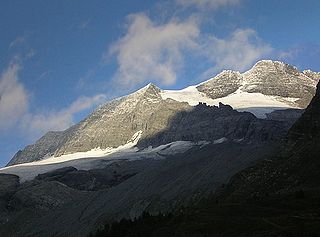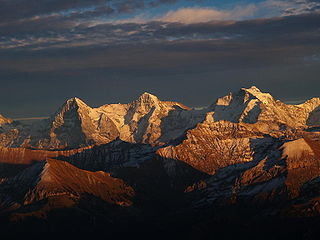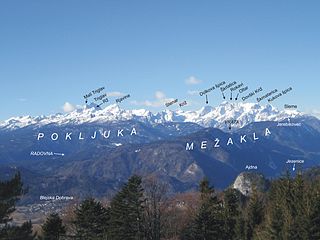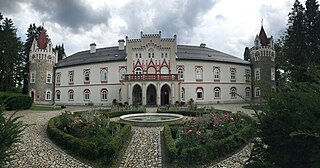
The Alps are the highest and most extensive mountain range that is entirely in Europe, stretching approximately 1,200 km (750 mi) across eight Alpine countries : Monaco, France, Switzerland, Italy, Liechtenstein, Germany, Austria and Slovenia.

The Lepontine Alps are a mountain range in the north-western part of the Alps. They are located in Switzerland and Italy.

The Alpine region of Switzerland, conventionally referred to as the Swiss Alps, represents a major natural feature of the country and is, along with the Swiss Plateau and the Swiss portion of the Jura Mountains, one of its three main physiographic regions. The Swiss Alps extend over both the Western Alps and the Eastern Alps, encompassing an area sometimes called Central Alps. While the northern ranges from the Bernese Alps to the Appenzell Alps are entirely in Switzerland, the southern ranges from the Mont Blanc massif to the Bernina massif are shared with other countries such as France, Italy, Austria and Liechtenstein.

The Pennine Alps French: Alpes Pennines, German: Walliser Alpen, Italian: Alpi Pennine, Latin: Alpes Poeninae), sometimes referred to as the Valais Alps, are a mountain range in the western part of the Alps. They are located in Italy and Switzerland (Valais).

The Bernese Alps are a mountain range of the Alps, located in western Switzerland. Although the name suggests that they are located in the Berner Oberland region of the canton of Bern, portions of the Bernese Alps are in the adjacent cantons of Valais, Fribourg and Vaud, the latter being usually named Fribourg Alps and Vaud Alps respectively. The highest mountain in the range, the Finsteraarhorn, is also the highest point in the canton of Bern.

The Julian Alps are a mountain range of the Southern Limestone Alps that stretch from northeastern Italy to Slovenia, where they rise to 2,864 m at Mount Triglav, the highest peak in Slovenia. A large part of the Julian Alps is included in Triglav National Park. The second highest peak of the range, the 2,755 m high Jôf di Montasio, lies in Italy.

The Gran Paradiso or Grand Paradis is a mountain in the Graian Alps in Italy, located between the Aosta Valley and Piedmont regions. It is located in Gran Paradiso National Park.

Kladno is a city in the Central Bohemian Region of the Czech Republic. It has about 68,000 inhabitants. It is the largest city in the region and has a rich industrial history.

The Northern Limestone Alps, also called the Northern Calcareous Alps, are the ranges of the Eastern Alps north of the Central Eastern Alps located in Austria and the adjacent Bavarian lands of southeastern Germany. The distinction from the latter group, where the higher peaks are located, is based on differences in geological composition.

In the folklore of the Alpine region of south-central Europe, the Tatzelwurm, Stollenwurm, or Stollwurm is a lizard-like creature, often described as having the face of a cat, with a serpent-like body which may be slender or stubby, with four short legs or two forelegs and no hindlegs.

The Varman dynasty (350–650) was the first historical dynasty of the Kamarupa kingdom. It was established by Pushyavarman, a contemporary of Samudragupta. The earlier Varmans were subordinates of the Gupta Empire, but as the power of the Guptas waned, Mahendravarman (470–494) performed two horse sacrifices and the status of Kamarupa as an independent state remained unimpaired. As per the Apsad Inscription of Adityasen, Susthivarman was defeated by Mahasengupta on the bank of Lauhitya. The first of the three Kamarupa dynasties, the Varmans were followed by the Mlechchha and then the Pala dynasties.

Dubí is a spa town in Teplice District in the Ústí nad Labem Region of the Czech Republic. It has about 8,000 inhabitants.

The Strahlhorn is a mountain of the Swiss Pennine Alps, located south of Saas-Fee and east of Zermatt in the canton of Valais. It lies on the range that separates the Mattertal from the Saastal and is located approximately halfway between the Rimpfischhorn and the Schwarzberghorn.

Pontoux is a commune in the Saône-et-Loire department in the region of Bourgogne-Franche-Comté in eastern France.

The Cavistrau is a mountain consisting of two summits in the Glarus Alps, overlooking Brigels and Trun in canton of Graubünden. The mountain belongs to the Brigelser Hörner, of which Cavistrau Grond is the highest and Cavistrau Pign, just 230 metres to its east side, the second highest. To its northern side above Val Frisal lies a nameless firn field.

Dubi Dam Dam is the debut single by German pop group Banaroo, which was released on 5 June 2005 from their debut album, Banaroo's World (2005).

Herálec is a municipality and village in Havlíčkův Brod District in the Vysočina Region of the Czech Republic. It has about 1,200 inhabitants.

The Brigelser Hörner is a mountain massif in the Glarus Alps, and a range overlooking Breil/Brigels and Trun in canton of Graubünden. To its northern side above Val Frisal lies a nameless firn field. They are connected to the north by the saddle Barcun risal Sut with Piz Frisal and Piz Durschin at the border to canton of Glarus.
Tsum is a language from the subgroup of Tibetic languages spoken by the Tsum people primarily in the Tsum Valley of the Gorka District of Nepal. The language is also known as Tsumke.


















